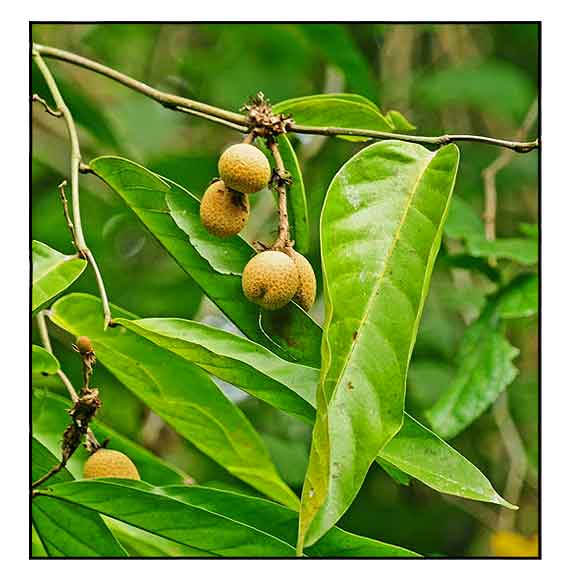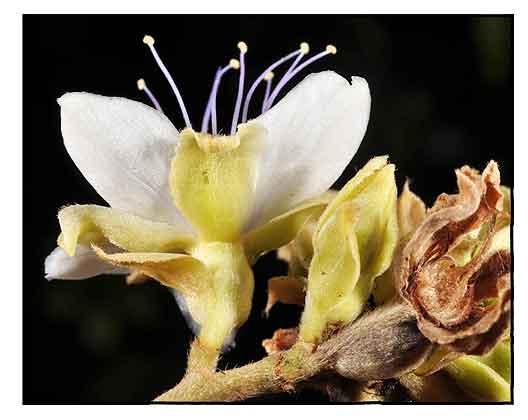 Gen info Gen info
- Atuna is a genus of plants in the family Chrysobalanaceae described as a genus in 1838.
- Etymology: The specific epithet racemosa derives from Latin meaning "clustered", referring to the inflorescence.
- Archaeological snippet: Remains of halved tabon-tabon fruits along side cut fish bones have been recovered from Barangay archaeological excavation site in Butuan (c. 10th to 13th century AD) indicating the cooking practice of kilawin using tabon-tabon is almost a thousand years old. (3)
- The most important product of Atuna racemosa is the fragrant oil. (see studies below) (12)
- Legend: A Samoan story is told of a beautiful princess Tasalu, envy of all men, who smelled heavenly because of her body oil, which was imitated and spread the use of ififi oil throughout Samoa. (12)
Botany
Atuna racemosa is a mid-canopy tree up to 31 m tall and 90 cm dbh. Stipules long and semi-persistent, especially conspicuous at the twig tip. Leaves alternate, simple, penni-veined. Flowers ca. 13 mm in diameter, white-yellowish, with long protruding anthers, placed in racemes. Fruits ca. 58 mm long, brownish, drupe. (2)
Distribution
- Native to the Philippines.
- Also native to Bismark Archipelago, Borneo, Caroline Is., Fiji, Malaya, Maluku, New Guinea, Samoa, Santa Cruz Is., Solomon Is., Sulawesi, Sumatera, Thailand, Tonga, Vanuatu, Wallis-Futuna Is.
(1)
- Grows primarily in the wet tropical biome.
- Found in mixed dipterocarp forests, in swamps and along rivers, from sea level to 750 mg altitude.
(3)
 Constituents Constituents
- Phytochemical screening of ethanolic extract of inner bark yielded flavonoids +++, alkaloids +, saponins +++, tannins +++. steroids +++, with absence of cyanogenic glycosides and anthraquinones. (see study below) (4)
- Alkaloids, anthraquinones, flavonoids, phenols and saponins were all detected in the 1%, 3% and 5% acetic acid extracts of A. racemosa fruits. (see study below) (8)
- Thin Layer Chromatography showed the endocarp extract contains phenols, tannins, flavonoids, alkaloids, coumarins, anthranoids and indoles. (see study below) ) (11)
Properties
- Studies have suggest antibacterial, antioxidant, cytotoxicity, antiplatelet aggregation properties.
Parts used
Bark, leaves, roots, oil.
 Uses Uses
Edibility
- Fruits are edible.
- In the Philippines, fruits are traditionally used
in the preparation of kinilaw (dish of raw fish in vinegar or citrus juices) to neutralize the fishy taste and acidity of the raw seafood dish. (3)
- In Mindanao, grated fruits used as fish condiment.
Folkloric
- No reported medicinal use in the Philippines.
-
In Samoa, decoction of inner bark drunk to treat severe abdominal pains. Oil applied on children to repel flies, to prevent scabies, soothe itching, and to ward off a cold.
- In the Solomon Is. used for diarrhea.
- Leaves used for treatment of swellings and inflammation. Roots used for treating infection of the soles of feet. Inner bark used for treatment of hypertension.
(4)
- In Samoa, decoction of inner living bark is immersed in water use to treat severe lower abdominal pains. Leaves used for swelling and inflammation. Leaves soaked in ififi oil is wrapped around swollen legs. Roots of ififi was used to treat Toga, an infection of the soles of feet, before the advent of antibiotics.
Others
- Crafts: In Fiji, leaves used for thatching walls of houses.
- Oil: Seeds yield an oil used as scent. The fragrant oil is considered the most important product. The oil is extracted from the ruminate cotyledons of the mature fruits. The oil is primarily used for massage. Also used for hair dressing, fly repellent. Used by fishermen going out at night to keep them warm.
- Caulking / Putty: The cotyledons of Atuna racemosa are macerated into a viscous putty-like consistency. They provide the preferred material for caulking boats and sealing canoes. It is claimed the type of caulking would last the lifetime of the boat. Also used for to waterproof baskets, sheaths, bamboo, and rattan objects, and as cement for inlays, shell work, and arrow flights. (12)
- Wood: Strong and resistant, attributed to silica content. Used in construction of houses.
Hard, light, and long-lasting, the wood is a fisherman's preference to sustain force when a large fish is caught. (12)
Studies
• Antibacterial / Antioxidant / Inner Bark: Study of ethanolic extract of inner bark showed antioxidant potential by DPPH assay. Antibacterial assay showed activity against Bacillus subtilis, Staphylococcus aureus, Escherichia coli, Klebsiella pneumonia, Salmonella typhimurium, and Pseudomonas aeruginosa. (see constituents above) (4)
• Effect of Kernel Maturity on Antibacterial Activity: Study showed the antibacterial properties differ at different stages of kernel maturity. Immature kernels have a lower minimal inhibitory concentration (MIC) than mature kernels. Also, there is a negative correlation between antibacterial property and cytotoxic properties i.e., a stronger antibiotic is less cytotoxic, suggesting there are two separate compounds with disparate characteristics. (5)
• Anti-MRSA (Methicillin-Resistant Staphylococcus aureus) / Kernel / Clinical Trial: Study reports the effectiveness of A. racemosa extract against MRSA is on par with currently available last-line antibiotics. Results of the randomized Phase 1 clinical trial suggests the extract well tolerated for topical use in humans at doses 10 time greater than the minimal inhibitory concentration for MRSA. (6)
• Hepatocytes Detoxify Atuna racemosa Extract: While traditional uses of Atuna racemosa suggest little indication for toxicity. Using jurkat T cells and HepG2 hepatocytes as model, the potential of the extract to target the liver was evaluated. Results suggest A. racemosa extract would likely be detoxified by the liver. Study suggests further invivo toxicological evaluation. (7)
• Cytotoxicity by Brine Shrimp Lethality Assay (BSLA) / Fruits: Study evaluated the cytotoxic activity of fruit by brine shrimp extract with varying acetic acid concentrations i.e. 1%, 3% and 5%. Results showed aqueous acetic acid extracts of A. racemosa fruits were cytotoxic against brine shrimp nauplii. The percentage mortality of the nauplii is directly proportional to the concentration of the extracting solvent - percent mortality of brine shrimp nauplii exposed to 5% AA extract was statistically higher compared to 1% and 3%. (8)
• Cytotoxicity by Brine Shrimp Lethality Assay (BSLA) / Shell and Seed: Study evaluated Atuna racemosa aqueous, ethyl acetate, methanol, and decocted shell and seed extracts for toxicity using BSLA. Results showed medium to highly toxic activity to brine shrimp nauplii at LC50 of 268.605 µg/mL (aqueous shell), 165.195 µg/mL (aqueous seed), 277.9 µg/mL (ethyl acetate shell), 419.919 µg/mL (EA seed),116.032 µg/mL (methanol shell), 92.0427 µg/mL (methanol seed), 482.78 µg/mL (decoction shell), and 121.111 µg/mL (decoction seed), respectively. The ethyl acetate and methanol extracts of seed showed good toxicological properties. (9)
• Effect of Storage on Oxidative Properties of Fruits: Study evaluated the effect of storage on antioxidative property of A. racemosa fruits. The antioxidative properties of aqueous acetic acid extracts were determined using DPPH radical scavenging and Reducing Power assay. Decrease in the DPPH inhibition and reducing power is more pronounced at ambient temperature (25°C) than at 4°C. Fruits stored under 4°C and ambient temperature (25°C) gave values for DPPH inhibition and reducing power activity in the order Day1>Day2>Day3. Results suggest anti- oxidative property of A. racemosa fruits is affected by storage temperature and duration. (10)
• Antiplatelet Aggregation / Endocarp: Study of Atuna racemosa endocarp extract showed antiplatelet aggregation effect on platelet suspension. Flavonoids, tannins and phenols may be responsible for the antiplatelet aggregation activity. (see constituents above) (11)
• Atuna Oil / Samoan Oil: The most important product of the plant is the fragrant oil, most preferred by Samoan healers. The preference has been attributed to the presence of flavan-3-ol derivative anti-inflammatory compounds 4'-MeO-(-)-gallocatechin and (+)-gallocatechin. The compounds have been found to be strong COX-1 inhibitors with weaker activity towards COX-2 enzyme. Ingredients sometimes added to Atuna to make Samoan oil include petals of Cananga odorata (ylang-ylang), leaves and/or fruits of Ocimum tenuiflorum, Citrus leaves, Cinnamomum verum leaves, bark of Alyxia stellata, or flowers of Aglaia samoensis. (12)
Availability
Wild-crafted.
|

![]()






